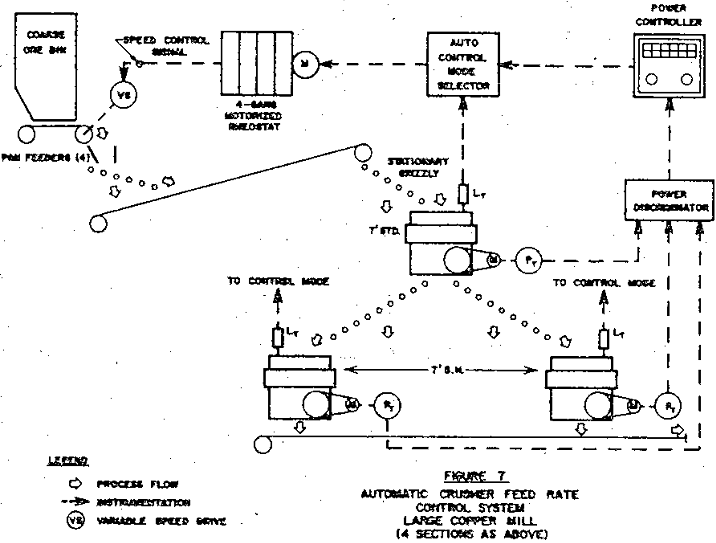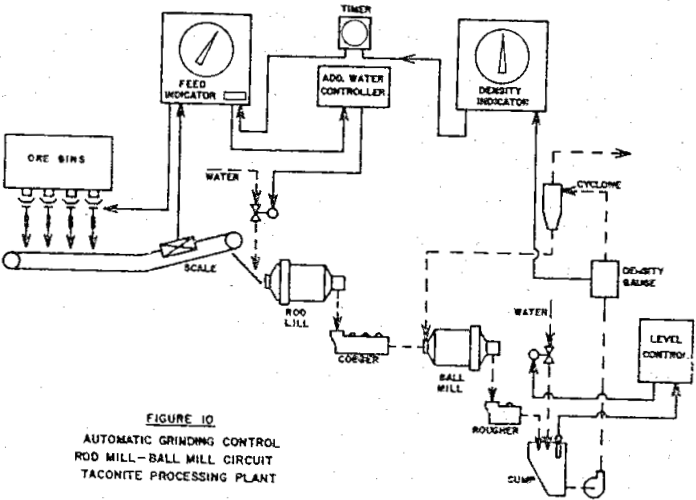Table of Contents
During the past two years, there has been an increasing acceptance of process automation among ferrous, non-ferrous and non-metallic rock processing operations in an attempt to keep total unit costs in line in a market situation where labor and material costs are rising almost daily.
The experienced crusher or mill designer and operator should know more about the ore or rock being processed, the processing techniques and the process equipment than anyone else. In this sense, his determination of the objectives to be realized in the control system plays a significant role in the degree of success that is attained.
Effective instrumentation and automatic control of crushing and grinding facilities in ore and rock crushing plants has been a practical reality for almost ten years. New and improved mechanisms and techniques are continually being developed that reduce the initial cost of these systems and exhibit significant improvements in reliability and serviceability.
Primary Crushing
From the standpoint of the process flowsheet, instrumentation in the primary crushing facility is a logical starting point. While there have been some notable successes in primary crushing plants employing no local operators, most primary facilities, large and small, continue to employ a local operator for a variety of reasons. The instrumentation that is presently applied in primary crushing facilities is used principally to assist the operator and to protect expensive process equipment. In this sense, capacity of the primary crusher is indirectly increased thru higher equipment availability.
Some of the devices currently employed in large primary crushing plants are shown in Figure 1. In this particular primary crusher facility, mine run ore is trucked to a dump position from which the ore is fed by a pan feeder. In many plants a level sensing device, Lt1, is employed to interlock the pan feeder drive and the truck dump light. This interlock merely protects the pan feeder from reaching too low a level such that a truck dumps on an empty feeder and causes physical damage. The sensing device in this case is usually a non-contact unit of the radioactivity or ultrasonic type.
Many of the same devices discussed under primary crusher instrumentation have been applied with equal success in the secondary and scale system, Wt, to weigh and totalize the product from the primary tertiary crushing stages. Typical of these are:
- Mantle Position Indicators
- Chute and transfer point plug detectors
- Tramp metal detectors
- Belt scale systems
While these devices can be extremely helpful to an operator, their influence on production is not nearly as marked as an effective crusher feed rate control system. Several different crushing plant flowsheets will be described and typical approaches to effective crusher feed control will be explained.
If the application of a crusher feed rate control system is to be successful, consideration must always be given to the capacity of material handling equipment associated with the crusher to be automated. That is, the tons per hour capacity of feeders, screens, chutes, etc., must be capable of handling the increased thru-put associated with a properly-automated crusher. Also, since some means of increasing and decreasing the feed to the crusher must be available, it is apparent that there must be some surge or storage capacity ahead of the crusher to be controlled as well as some kind of an adjustable speed or amplitude feeder.
Grinding Control
With all the sophistication that has found its way into some grinding circuit automatic control systems, the basis for almost all successful systems should be, in my judgement, an effective feed rate control system to the first stage grinding mill.
It just stands to reason that under a given set of ore and operating conditions, all types and sizes of grinding mills will operate most efficiently if they are fed an optimum rate of ore and are grinding at some optimum pulp density within the mill (assuming a wet grind).
One of the earliest, large scale plants to successfully employ automatic grinding control was a taconite mill in Northern Minnesota. This system went “on line” in the early ’60’s and has operated continuously ever since.
The grinding circuit control system includes the usual rod mill feed rate control system and water-to-ore ratio system. Circulating load is measured by means of a pulp density measurement in the cyclone feed line. In this specific arrangement of process equipment, cyclone feed density measurement is meaningful only if the ball mill sump level is precisely controlled to maintain a constant head on the pump. In spite of the fact that instrumentation employed to effect automatic grinding circuit control in this plant is considered obsolete by present day standards, this plant has, for over eight years, maintained the desired grind within very narrow tolerances.
In the plant illustrated, power developed by the ball mill drive is employed as a measurement of mill load and this signal used to adjust the feed rate of ore. This approach its effective in this unique case because the feed to the ball mill is -3″ material and the ore charge in the mill is relatively large compared with the ball charge in a mill operated more conventionally.
Note that sump level is controlled by varying the speed of the pump and that a density measurement in the cyclone overflow is used to control water addition in the sump.. This grinding circuit control system has been very effective and has contributed to increasing the capacity of the mill to almost twice that of its original design capacity.












